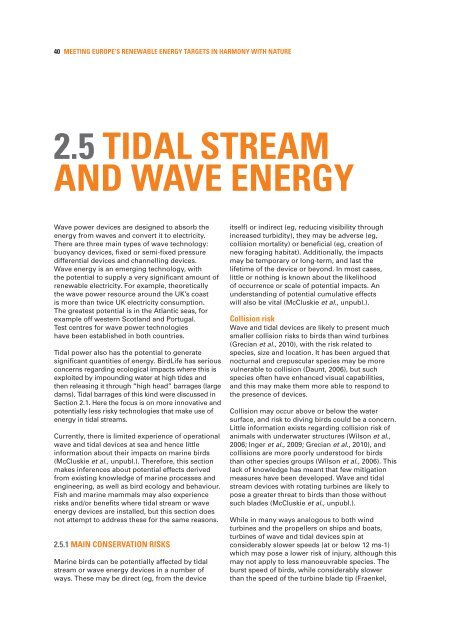Meeting Europe's renewable energy targets in harmony with - RSPB
Meeting Europe's renewable energy targets in harmony with - RSPB
Meeting Europe's renewable energy targets in harmony with - RSPB
Create successful ePaper yourself
Turn your PDF publications into a flip-book with our unique Google optimized e-Paper software.
40 MEETING EUROPE’S RENEWABLE ENERGY TARGETS IN HARMONY WITH NATURE<br />
2.5 TIDAL STREAM<br />
AND WAVE ENERGY<br />
Wave power devices are designed to absorb the<br />
<strong>energy</strong> from waves and convert it to electricity.<br />
There are three ma<strong>in</strong> types of wave technology:<br />
buoyancy devices, fixed or semi-fixed pressure<br />
differential devices and channell<strong>in</strong>g devices.<br />
Wave <strong>energy</strong> is an emerg<strong>in</strong>g technology, <strong>with</strong><br />
the potential to supply a very significant amount of<br />
<strong>renewable</strong> electricity. For example, theoretically<br />
the wave power resource around the UK’s coast<br />
is more than twice UK electricity consumption.<br />
The greatest potential is <strong>in</strong> the Atlantic seas, for<br />
example off western Scotland and Portugal.<br />
Test centres for wave power technologies<br />
have been established <strong>in</strong> both countries.<br />
Tidal power also has the potential to generate<br />
significant quantities of <strong>energy</strong>. BirdLife has serious<br />
concerns regard<strong>in</strong>g ecological impacts where this is<br />
exploited by impound<strong>in</strong>g water at high tides and<br />
then releas<strong>in</strong>g it through “high head” barrages (large<br />
dams). Tidal barrages of this k<strong>in</strong>d were discussed <strong>in</strong><br />
Section 2.1. Here the focus is on more <strong>in</strong>novative and<br />
potentially less risky technologies that make use of<br />
<strong>energy</strong> <strong>in</strong> tidal streams.<br />
Currently, there is limited experience of operational<br />
wave and tidal devices at sea and hence little<br />
<strong>in</strong>formation about their impacts on mar<strong>in</strong>e birds<br />
(McCluskie et al., unpubl.). Therefore, this section<br />
makes <strong>in</strong>ferences about potential effects derived<br />
from exist<strong>in</strong>g knowledge of mar<strong>in</strong>e processes and<br />
eng<strong>in</strong>eer<strong>in</strong>g, as well as bird ecology and behaviour.<br />
Fish and mar<strong>in</strong>e mammals may also experience<br />
risks and/or benefits where tidal stream or wave<br />
<strong>energy</strong> devices are <strong>in</strong>stalled, but this section does<br />
not attempt to address these for the same reasons.<br />
2.5.1 MAIN CONSERVATION RISKS<br />
Mar<strong>in</strong>e birds can be potentially affected by tidal<br />
stream or wave <strong>energy</strong> devices <strong>in</strong> a number of<br />
ways. These may be direct (eg, from the device<br />
itself) or <strong>in</strong>direct (eg, reduc<strong>in</strong>g visibility through<br />
<strong>in</strong>creased turbidity), they may be adverse (eg,<br />
collision mortality) or beneficial (eg, creation of<br />
new forag<strong>in</strong>g habitat). Additionally, the impacts<br />
may be temporary or long-term, and last the<br />
lifetime of the device or beyond. In most cases,<br />
little or noth<strong>in</strong>g is known about the likelihood<br />
of occurrence or scale of potential impacts. An<br />
understand<strong>in</strong>g of potential cumulative effects<br />
will also be vital (McCluskie et al., unpubl.).<br />
Collision risk<br />
Wave and tidal devices are likely to present much<br />
smaller collision risks to birds than w<strong>in</strong>d turb<strong>in</strong>es<br />
(Grecian et al., 2010), <strong>with</strong> the risk related to<br />
species, size and location. It has been argued that<br />
nocturnal and crepuscular species may be more<br />
vulnerable to collision (Daunt, 2006), but such<br />
species often have enhanced visual capabilities,<br />
and this may make them more able to respond to<br />
the presence of devices.<br />
Collision may occur above or below the water<br />
surface, and risk to div<strong>in</strong>g birds could be a concern.<br />
Little <strong>in</strong>formation exists regard<strong>in</strong>g collision risk of<br />
animals <strong>with</strong> underwater structures (Wilson et al.,<br />
2006; Inger et al., 2009; Grecian et al., 2010), and<br />
collisions are more poorly understood for birds<br />
than other species groups (Wilson et al., 2006). This<br />
lack of knowledge has meant that few mitigation<br />
measures have been developed. Wave and tidal<br />
stream devices <strong>with</strong> rotat<strong>in</strong>g turb<strong>in</strong>es are likely to<br />
pose a greater threat to birds than those <strong>with</strong>out<br />
such blades (McCluskie et al., unpubl.).<br />
While <strong>in</strong> many ways analogous to both w<strong>in</strong>d<br />
turb<strong>in</strong>es and the propellers on ships and boats,<br />
turb<strong>in</strong>es of wave and tidal devices sp<strong>in</strong> at<br />
considerably slower speeds (at or below 12 ms-1)<br />
which may pose a lower risk of <strong>in</strong>jury, although this<br />
may not apply to less manoeuvrable species. The<br />
burst speed of birds, while considerably slower<br />
than the speed of the turb<strong>in</strong>e blade tip (Fraenkel,
















